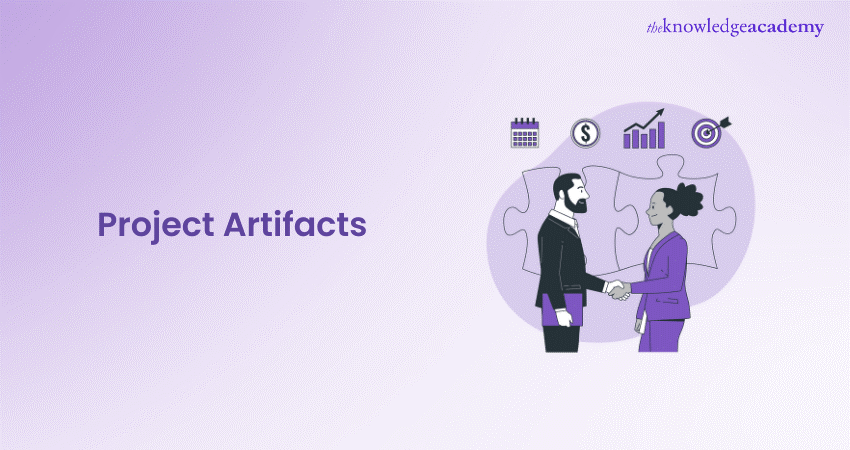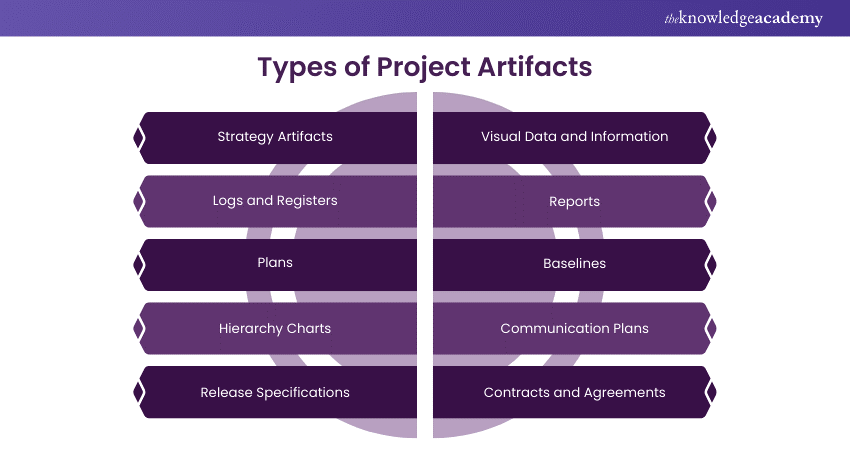We may not have the course you’re looking for. If you enquire or give us a call on 01344203999 and speak to our training experts, we may still be able to help with your training requirements.
We ensure quality, budget-alignment, and timely delivery by our expert instructors.

Imagine a blueprint for a building. It's a detailed representation, a crucial artifact for the construction process. Project Artifacts serve a similar purpose in Project Management. They are the tangible outputs and documentation that guide a project from inception to completion.
From project plans and requirements documents to test cases and user manuals, artifacts ensure clarity, accountability, and success. This comprehensive blog will explore the various types of Project Artifacts, their importance, and best practices for managing them. Join us as we delve into the world of Project Artifacts.
Table of Contents
1) What is a Project Artifact?
2) Types of Project Artifacts
a) Strategy Artifacts
b) Logs and Registers
c) Plans
d) Hierarchy Charts
e) Release Specifications
e) Visual Data and Information
f) Reports
g) Baselines
h) Communication Plans
i) Contracts and Agreements
3) Conclusion
What is a Project Artifact?
In the landscape of project management, a Project Artifact is any document, template, or deliverable crafted during the process. These artifacts, which can emerge at any stage from initiation to closure, are essential tools. They disseminate information, track progress, manage risks, and ensure the project stays aligned with its goals. Whether they are physical documents, digital files, or conceptual frameworks, these artifacts are the beacons that guide project decisions and actions.
The primary purpose of Project Artifacts is to provide a record of the project's progress and to ensure that all stakeholders are on the same page. They serve as reference points, including the Feasibility Study, that can be reviewed, updated, and used to make informed decisions throughout the project lifecycle. In essence, Project Artifacts are the backbone of project documentation, ensuring that every aspect of the project is carefully planned, monitored, and controlled.
Types of Project Artifacts
Project Artifacts come in many forms, each serving a unique purpose within the Project Management process. Here, we explore ten key types of Project Artifacts that are crucial for effective Project Management.

1) Strategy Artifacts
Strategy artifacts are foundational documents that outline the project's objectives, goals, and overall approach. These artifacts include project charters, business cases, and feasibility studies. They define the project's scope, identify key stakeholders, and establish the project's strategic direction. Strategy artifacts are critical for aligning the project with the organisation's broader objectives and ensuring that all team members understand the project's purpose and expected outcomes.
For example, a project charter serves as a formal document that authorises the project, outlining its objectives, scope, and key stakeholders. It acts as a reference point for the entire project, guiding decision-making and ensuring that the project remains aligned with its strategic goals.
2) Logs and Registers
Logs and registers are essential Project Artifacts used to track various elements of the project. Among these, the Issue Log in Project Management plays a crucial role in documenting and managing project-related issues. These artifacts, including risk registers, issue logs, and change logs, help project managers monitor potential risks, track emerging issues, and manage changes to the project scope or deliverables. By maintaining accurate logs and registers, project managers can proactively address challenges and ensure that the project stays on track.
A risk register, for example, is a document that identifies potential risks, assesses their impact, and outlines mitigation strategies. It is a dynamic document that is updated regularly as new risks emerge and existing risks are resolved.
3) Plans
Planning is yet another critical phase, and plans are essential artifacts that guide the project's execution. These artifacts include Project Management plans, work breakdown structures (WBS), and resource allocation plans. They provide detailed blueprints for how the project will be executed, monitored, and controlled. Plans help ensure that all aspects of the project are carefully considered and that resources are allocated effectively.
A Project Management plan, for instance, is a detailed document that outlines how the project will be managed, including scope, schedule, cost, quality, and communication plans. It serves as the central document that guides the project's execution and ensures that all team members are aligned with the project's objectives.
Get started on your Project Management journey – Join our introductory Project Management Certification today!
4) Hierarchy Charts
Hierarchy charts, such as organisational charts and Responsibility Assignment Matrices (RAM), are visual representations of the project's structure and roles. These artifacts clarify the relationships between team members, define reporting lines, and assign responsibilities. Hierarchy charts are essential for ensuring that everyone included in the project understands their role and how they fit into the larger project structure.
An organisational chart, for example, visually depicts the project's team structure, showing the hierarchy of roles and the relationships between team members. This chart helps project managers ensure that all roles are well defined and that team members understand their responsibilities.
5) Release Specifications
Release specifications are artifacts that outline the requirements and criteria for releasing project deliverables. These artifacts include product specifications, acceptance criteria, and quality checklists. They ensure that deliverables meet the required standards and that stakeholders are satisfied with the final product. Release specifications are critical for maintaining quality and ensuring that the project meets its objectives.
For example, a product specification document outlines the technical requirements and features of a product. It serves as a reference for the development team to ensure the end product meets project specifications and quality standards.
6) Visual Data and Information
Visual data and information artifacts include charts, graphs, and diagrams that represent project data in a visual format. These artifacts are used to communicate complex information in a clear and concise manner. They help stakeholders quickly understand project status, progress, and trends. Visual data and information artifacts are particularly useful for presenting project metrics and performance data.
A Gantt chart, for example, is a visual representation of the project schedule, showing tasks, milestones, and dependencies. It provides a clear overview of the project's timeline and helps project managers track progress and identify potential delays.
7) Reports
Reports are critical Project Artifacts that document the project's status, progress, and outcomes. These artifacts include status reports, progress reports, and performance reports. Reports provide stakeholders with regular updates on the project's progress, highlight any issues or risks, and document the project's achievements. They are essential for maintaining transparency and ensuring that stakeholders are informed throughout the project lifecycle.
A status report, for example, provides a snapshot of the project's current state, including progress, issues, and upcoming milestones. It is a key communication tool that helps keep stakeholders informed and engaged.
8) Baselines
Baselines are Project Artifacts that establish the project's original scope, schedule, and cost. These artifacts include scope baselines, schedule baselines, and cost baselines. Baselines serve as reference points that allow project managers to measure performance and track deviations from the original plan. They are crucial for project control and keeping it on track.
A schedule baseline, for instance, is the approved project timeline that serves as a reference for tracking progress. It enables project managers to compare actual performance with the planned schedule and identify any variances.
9) Communication Plans
Communication plans are artifacts that outline how information will be shared and communicated throughout the project. These artifacts include stakeholder communication plans, meeting agendas, and communication logs. Communication plans ensure that all stakeholders are informed and that information flows smoothly between team members. They are essential for maintaining transparency and ensuring that everyone is on the same page.
A stakeholder communication plan, for example, outlines how and when stakeholders will be informed about the project's progress. It ensures that stakeholders receive regular updates and that their concerns and feedback are addressed.
Master the Essentials of Project Management – Join Our PM² Trainings Now!
10) Contracts and Agreements
Contracts and agreements are formal Project Artifacts that define the terms and conditions of the project's deliverables and relationships. These artifacts include contracts, service level agreements (SLAs), and memorandums of understanding (MOUs). They provide legal and contractual frameworks that govern the project's execution and ensure that all parties are aware of their obligations and responsibilities.
A contract is a legally binding document that specifies the terms of the agreement between the project team and external vendors or contractors, ensuring all parties understand their obligations and that the project is executed as agreed.
Conclusion
Project Artifacts are essential tools for successful Project Management. They provide a structured framework for planning, executing, monitoring, and closing projects. By understanding the various types of Project Artifacts and their significance, project managers can ensure that their projects are well-documented, transparent, and aligned with their strategic goals.
Kickstart your Project Management career – Join our PM² Foundation Training today!
Frequently Asked Questions
Can Artifacts be Reused in Future Projects?

Yes, Project Artifacts can be reused in future projects. Reusing artifacts like templates, plans, and reports saves time, ensures consistency, and leverages proven approaches, helping streamline processes and maintain high standards across multiple projects.
How can Stakeholders Access and use Project Artifacts Effectively?

Stakeholders can access and use Project Artifacts effectively by utilising a centralised, well-organised document management system. Regular updates, clear version control, and accessible communication channels ensure stakeholders have timely access to relevant artifacts, facilitating informed decision-making and collaboration.
How do Project Artifacts Evolve Throughout the Project Lifecycle?

Project Artifacts evolve by being continuously updated and refined as the project progresses. Initial drafts are expanded with new information, adjusted for changes, and finalised.
What are the Other Resources and Offers Provided by The Knowledge Academy?

The Knowledge Academy takes global learning to new heights, offering over 30,000 online courses across 490+ locations in 220 countries. This expansive reach ensures accessibility and convenience for learners worldwide.
Alongside our diverse Online Course Catalogue, encompassing 19 major categories, we go the extra mile by providing a plethora of free educational Online Resources like News updates, Blogs, videos, webinars, and interview questions. Tailoring learning experiences further, professionals can maximise value with customisable Course Bundles of TKA.
What is The Knowledge Pass, and How Does it Work?

The Knowledge Academy’s Knowledge Pass, a prepaid voucher, adds another layer of flexibility, allowing course bookings over a 12-month period. Join us on a journey where education knows no bounds.
What are the Related Courses and Blogs Provided by The Knowledge Academy?

The Knowledge Academy offers various PM² Project Management Trainings, including the PM² Foundation Training. These courses cater to different skill levels, providing comprehensive insights into Project Status Report.
Our Project Management Blogs cover a range of topics related to Project Artifacts, offering valuable resources, best practices, and industry insights. Whether you are a beginner or looking to advance your Project Management skills, The Knowledge Academy's diverse courses and informative blogs have got you covered.
Upcoming Project Management Resources Batches & Dates
Date
 PM² Foundation Training
PM² Foundation Training
Thu 5th Jun 2025
Thu 7th Aug 2025
Thu 2nd Oct 2025
Thu 4th Dec 2025






 Top Rated Course
Top Rated Course



 If you wish to make any changes to your course, please
If you wish to make any changes to your course, please


